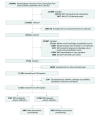Prevalence of Antibiotic-Resistant Pathogens in Culture-Proven Sepsis and Outcomes Associated With Inadequate and Broad-Spectrum Empiric Antibiotic Use
- PMID: 32297949
- PMCID: PMC7163409
- DOI: 10.1001/jamanetworkopen.2020.2899
Prevalence of Antibiotic-Resistant Pathogens in Culture-Proven Sepsis and Outcomes Associated With Inadequate and Broad-Spectrum Empiric Antibiotic Use
Abstract
Importance: Broad-spectrum antibiotics are recommended for all patients with suspected sepsis to minimize the risk of undertreatment. However, little is known regarding the net prevalence of antibiotic-resistant pathogens across all patients with community-onset sepsis or the outcomes associated with unnecessarily broad empiric treatment.
Objective: To elucidate the epidemiology of antibiotic-resistant pathogens and the outcomes associated with both undertreatment and overtreatment in patients with culture-positive community-onset sepsis.
Design, setting, and participants: This cohort study included 17 430 adults admitted to 104 US hospitals between January 2009 and December 2015 with sepsis and positive clinical cultures within 2 days of admission. Data analysis took place from January 2018 to December 2019.
Exposures: Inadequate empiric antibiotic therapy (ie, ≥1 pathogen nonsusceptible to all antibiotics administered on the first or second day of treatment) and unnecessarily broad empiric therapy (ie, active against methicillin-resistant Staphylococcus aureus [MRSA]; vancomycin-resistant Enterococcus [VRE]; ceftriaxone-resistant gram-negative [CTX-RO] organisms, including Pseudomonas aeruginosa; or extended-spectrum β-lactamase [ESBL] gram-negative organisms when none of these were isolated).
Main outcomes and measures: Prevalence and empiric treatment rates for antibiotic-resistant organisms and associations of inadequate and unnecessarily broad empiric therapy with in-hospital mortality were assessed, adjusting for baseline characteristics and severity of illness.
Results: Of 17 430 patients with culture-positive community-onset sepsis (median [interquartile range] age, 69 [57-81] years; 9737 [55.9%] women), 2865 (16.4%) died in the hospital. The most common culture-positive sites were urine (9077 [52.1%]), blood (6968 [40.0%]), and the respiratory tract (2912 [16.7%]). The most common pathogens were Escherichia coli (5873 [33.7%]), S aureus (3706 [21.3%]), and Streptococcus species (2361 [13.5%]). Among 15 183 cases in which all antibiotic-pathogen susceptibility combinations could be calculated, most (12 398 [81.6%]) received adequate empiric antibiotics. Empiric therapy targeted resistant organisms in 11 683 of 17 430 cases (67.0%; primarily vancomycin and anti-Pseudomonal β-lactams), but resistant organisms were uncommon (MRSA, 2045 [11.7%]; CTX-RO, 2278 [13.1%]; VRE, 360 [2.1%]; ESBLs, 133 [0.8%]). The net prevalence for at least 1 resistant gram-positive organism (ie, MRSA or VRE) was 13.6% (2376 patients), and for at least 1 resistant gram-negative organism (ie, CTX-RO, ESBL, or CRE), it was 13.2% (2297 patients). Both inadequate and unnecessarily broad empiric antibiotics were associated with higher mortality after detailed risk adjustment (inadequate empiric antibiotics: odds ratio, 1.19; 95% CI, 1.03-1.37; P = .02; unnecessarily broad empiric antibiotics: odds ratio, 1.22; 95% CI, 1.06-1.40; P = .007).
Conclusions and relevance: In this study, most patients with community-onset sepsis did not have resistant pathogens, yet broad-spectrum antibiotics were frequently administered. Both inadequate and unnecessarily broad empiric antibiotics were associated with higher mortality. These findings underscore the need for better tests to rapidly identify patients with resistant pathogens and for more judicious use of broad-spectrum antibiotics for empiric sepsis treatment.
Conflict of interest statement
Figures



References
-
- Rhee C, Jones TM, Hamad Y, et al. ; Centers for Disease Control and Prevention (CDC) Prevention Epicenters Program . Prevalence, underlying causes, and preventability of sepsis-associated mortality in US acute care hospitals. JAMA Netw Open. 2019;2(2):e187571. doi:10.1001/jamanetworkopen.2018.7571 - DOI - PMC - PubMed
-
- Vazquez-Guillamet C, Scolari M, Zilberberg MD, Shorr AF, Micek ST, Kollef M. Using the number needed to treat to assess appropriate antimicrobial therapy as a determinant of outcome in severe sepsis and septic shock. Crit Care Med. 2014;42(11):2342-2349. doi:10.1097/CCM.0000000000000516 - DOI - PubMed
Publication types
MeSH terms
Substances
Grants and funding
LinkOut - more resources
Full Text Sources
Medical
Research Materials

